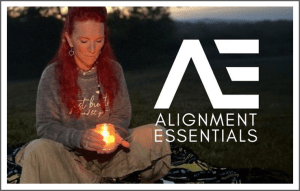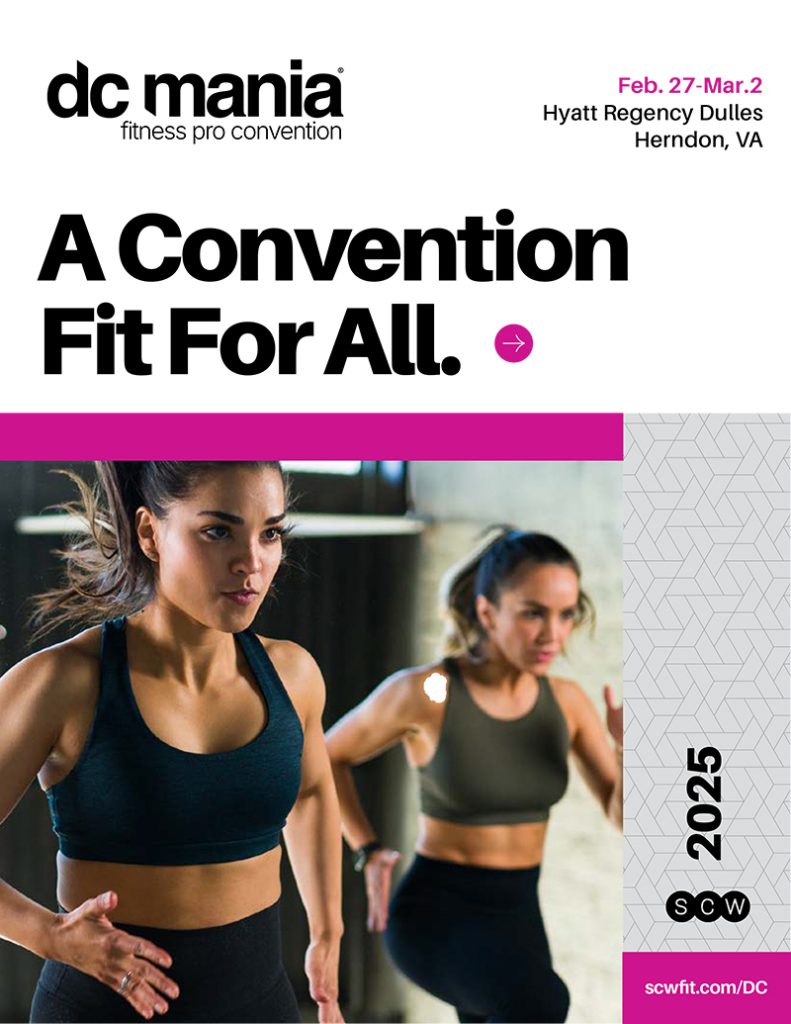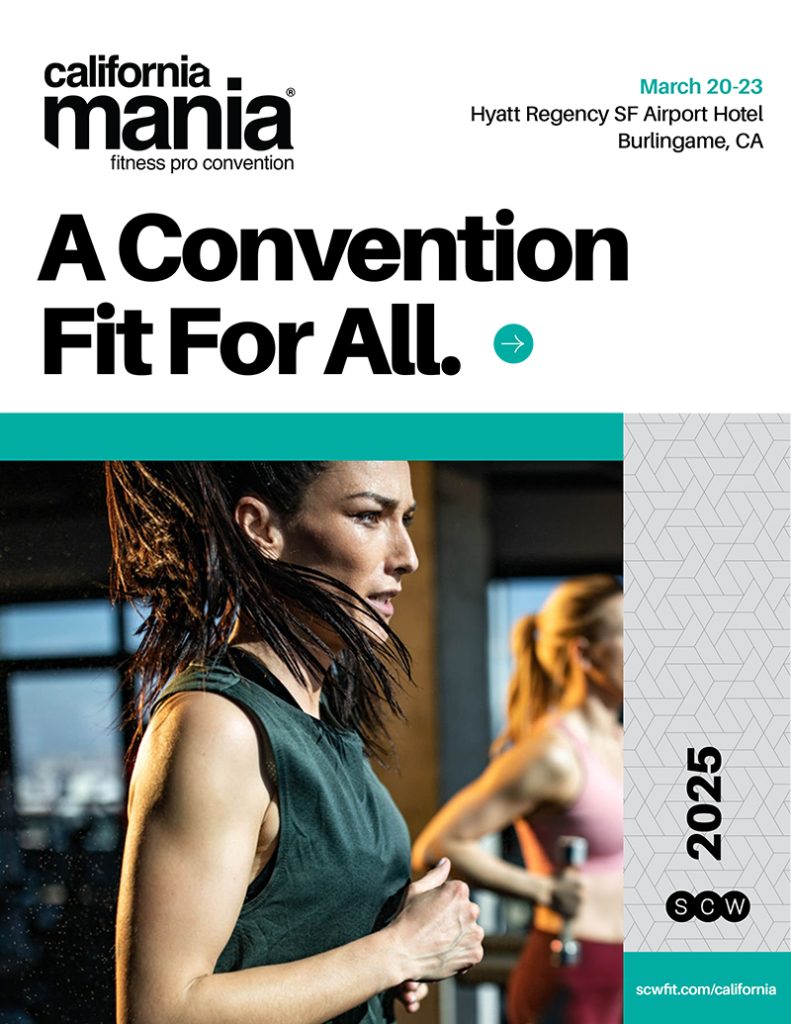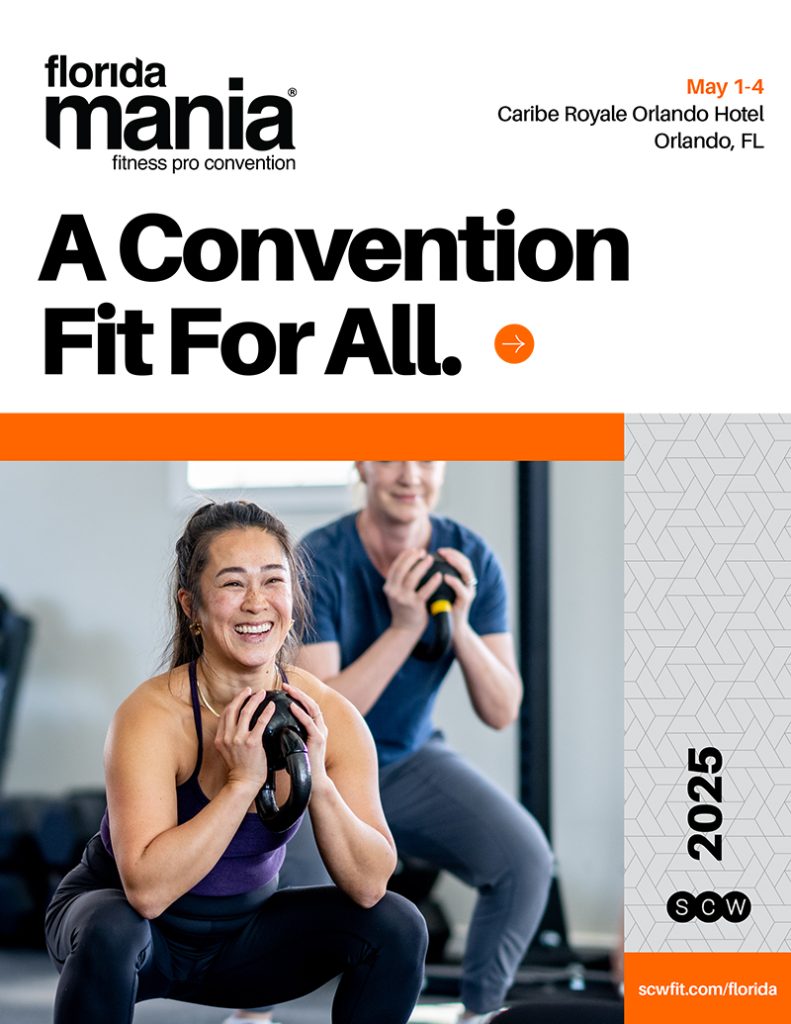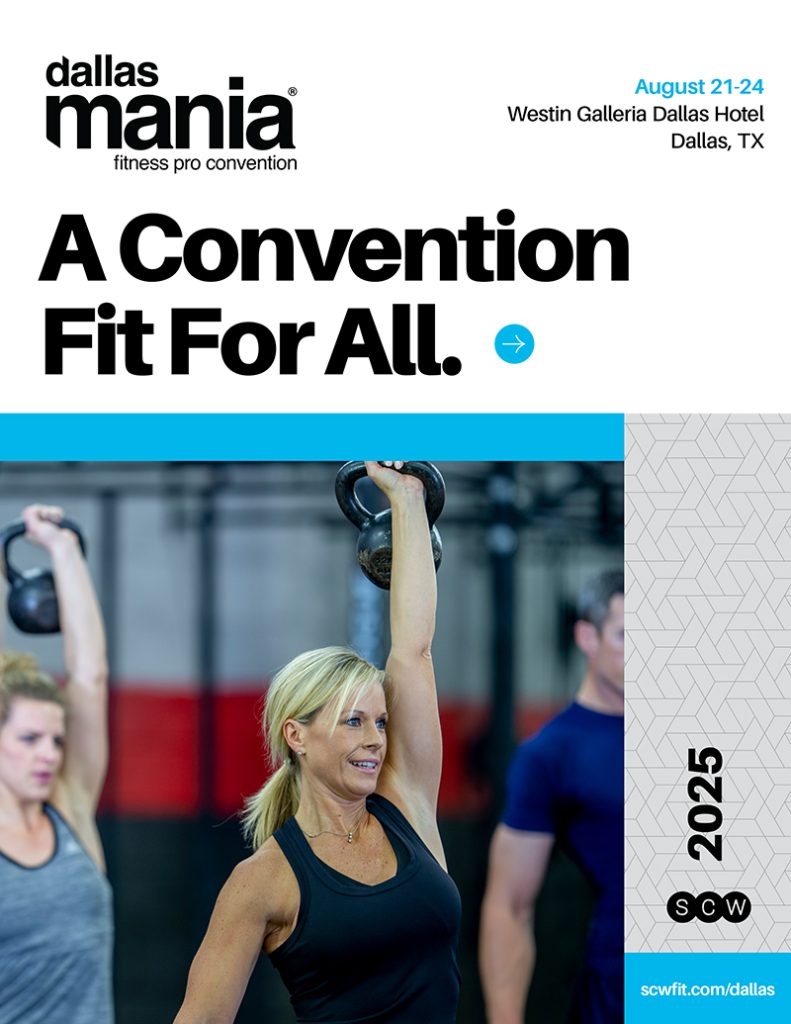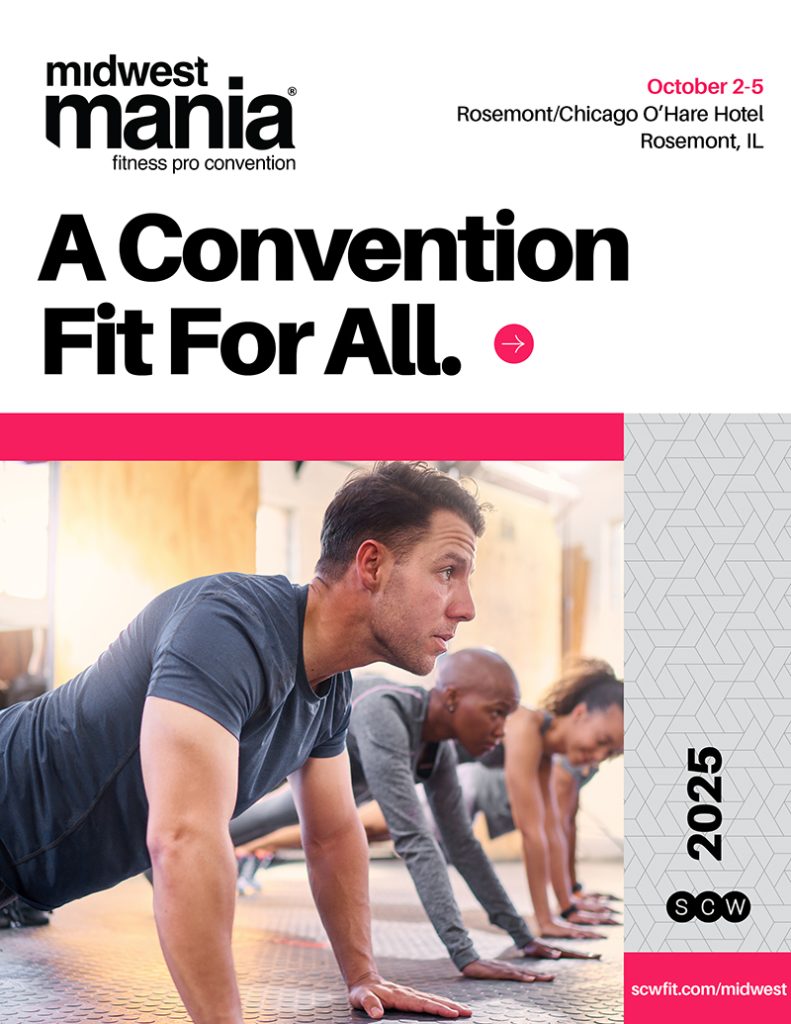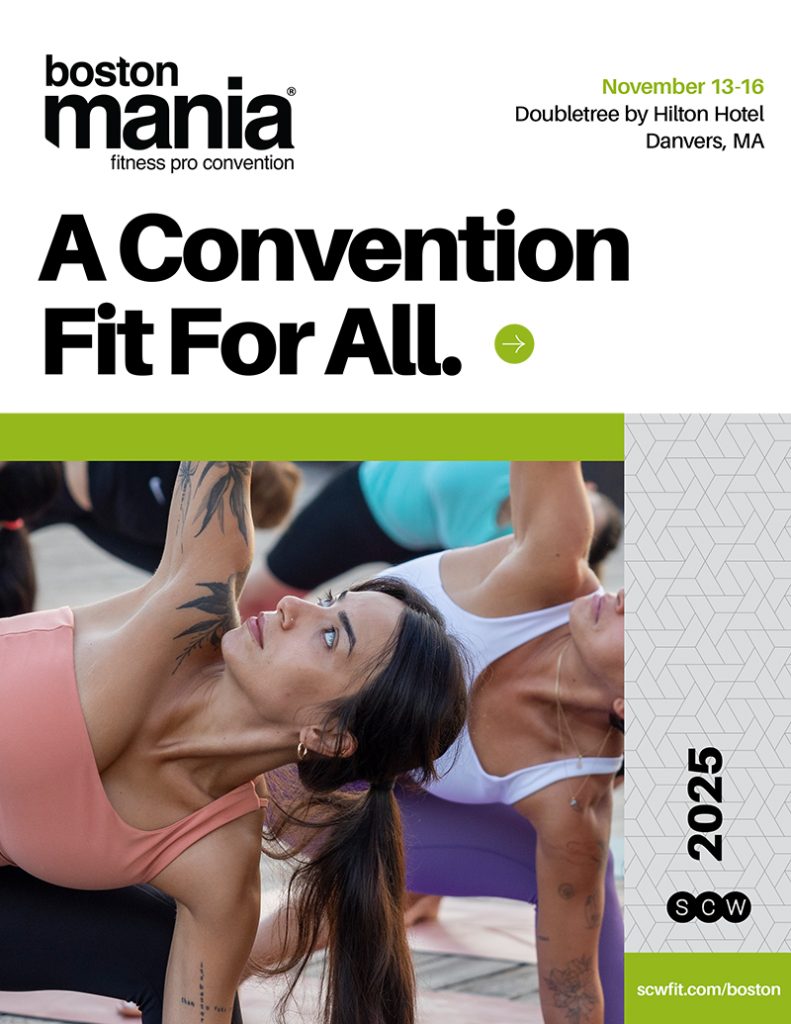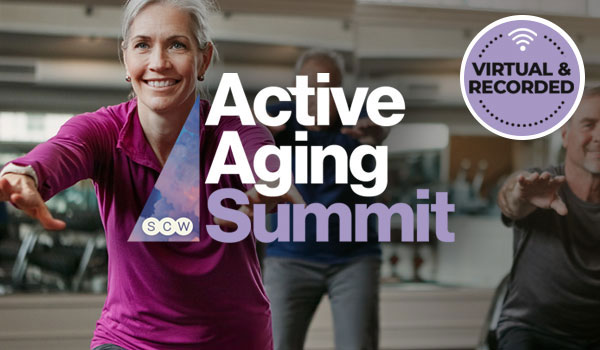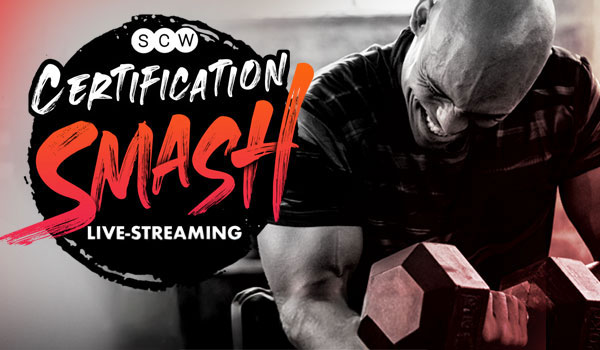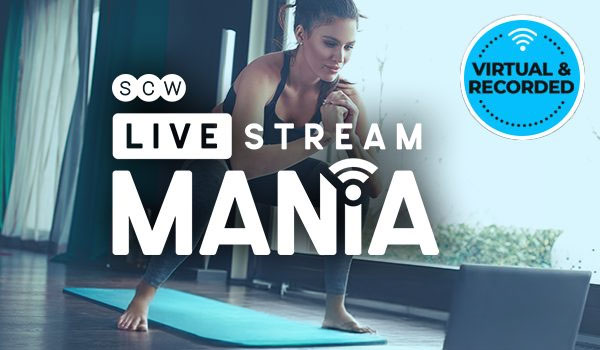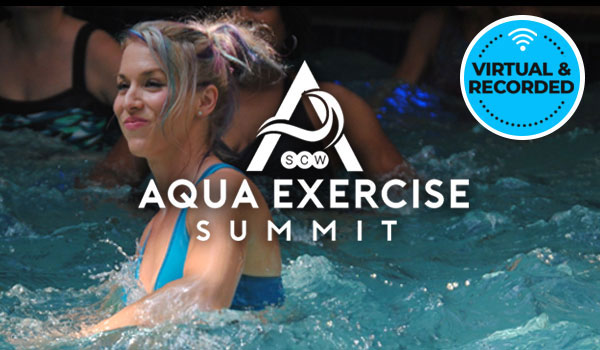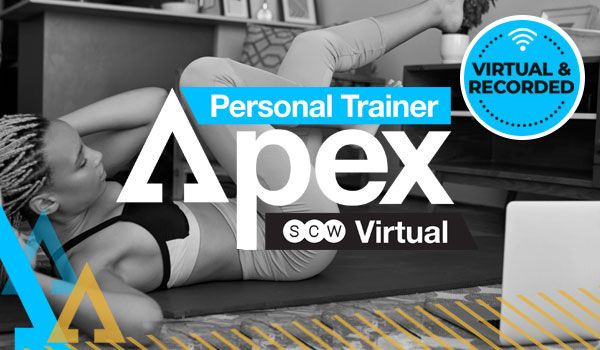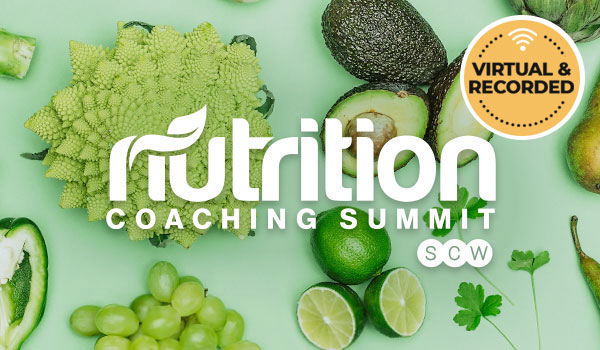
SCW Spotlite: Issue 67

Trends for 2024: A Leader’s Perspective
by SCW Faculty Presenters
Every year, in almost every industry, generalized predictions are made for upcoming trends, but rarely are the opinions personalized. This year, SCW Fitness chose a different approach by reaching out to some of the Fitness Industry’s Top Icons. We asked them five questions regarding not only trends, but programming, implementation, engagement, and integration. Their answers may not only surprise you but make you think outside the box. Hopefully, these four diverse perspectives will provide the solution needed to assist you, your staff, your facility, and your members to grow in 2024.
We decided to write this article more as an interview versus a conglomeration. This format should make the information easier to comprehend and digest and to share with others interested in learning predictions for this year.
Question 1: What are the top three fitness trends you see for 2024?
Melissa
#1 – Living In the South it’s Back to the Basics -what was old is new again. Atlanta shows step, kickboxing, strength training, and mind-body pulling in the gym goers.
#2 – Active Agers are still BIG in all parts of our gym, from the pool to large group. We just started a small group active agers functional training program, replacing a prime-time boot camp with Shabam.
#3 – Women Specific Training – menopause, pelvic floor focus in Pilates and strength training, stress relief in yoga (we have specific hip opener classes that are packed.) As we age, we have the discretionary income to pay for what we specifically want out of our programming and our mortality becomes more eminent as we see friends, coworkers, and longtime acquaintances passing away. Active agers have been around the block long enough to know that leaving a class feeling like you’ve been beaten up and run over by a dump truck isn’t functional fitness. (I’m not going to do burpees to get my cat’s toy out from under the sofa so why should I do them in class? I do, however, have stress incontinence so I want my gym workout to at least incorporate that, if not focus on it.)
Irene
#1 – Blended Programming – This would include taking a more comprehensive approach to personalized programming or personal training. Also, an emphasis on a whole-body approach to fitness, not just exercise. There is a focus on sleep, pre and post-workout feeding, stress management, an examination of the relationship between nutrition and inflammation, along with strategies and activities to maintain self-care routines including an increase in self-confidence.
#2 – Menopause and Pelvic Floor Research is an area that has simmered under the surface for a while. Neither subject was addressed or dealt with at all in the fitness industry until only recently. I for one am excited about the new research, especially the role that specific hormones play in perimenopause, menopause, and beyond into older adulthood. (On a side note, Pelvic Floor Therapy should be offered to every woman during her post-partum period. Insurance companies should be footing the bill for this preventative and cost-effective, routine practice health care issue. It is restorative and necessary for recovery after childbirth.)
#3 – Traditional Pilates Mat & 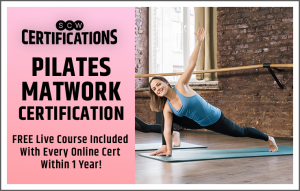 Reformer (duets and trios are making another big entrance in the semi-private and small-group spaces. Recently, I was in Korea at a fitness conference and almost all program offerings were Pilates-focused. With the increased focus on restoration, maintenance, and recovery, the reformer can be adapted to meet the needs of many people. It is also getting easy to find high-quality, less-expensive models, as the equipment associated with the reformer can be cost-prohibitive.
Reformer (duets and trios are making another big entrance in the semi-private and small-group spaces. Recently, I was in Korea at a fitness conference and almost all program offerings were Pilates-focused. With the increased focus on restoration, maintenance, and recovery, the reformer can be adapted to meet the needs of many people. It is also getting easy to find high-quality, less-expensive models, as the equipment associated with the reformer can be cost-prohibitive.
Gail
#1 – Virtual Fitness and Technology Integration is likely to continue growing with technology-assisted workouts, interactive platforms, and wearables becoming more prevalent.
#2 – Holistic Wellness Programs that focus on overall well-being, including mental health, nutrition, and mindfulness, are expected to increase. Fitness programs that offer a holistic approach to health will likely gain popularity as well.
#3 – Personalized Fitness, otherwise referred to as a tailored workout plan, and individual fitness experiences based on specific needs, preferences, and health data are likely to be a prominent trend. This could involve AI-driven fitness recommendations and adaptive training programs.
Sheldon
#1 – Artificial Intelligence is huge and can offer personalized programming, interactive member engagement, and cutting-edge content creation for marketing.
#2 – Integrated Wellness addresses diverse needs, embracing active agers, health seekers, and mental wellness enthusiasts. Advanced technology and wearables seamlessly weave these aspects into holistic fitness journeys.
#3 – Recovery Services and Biohacking introduce assistances like stretching, meditation, compression, lymphatic drainage, light therapy, cold immersion, and so much more. Unveiling the secrets of recovery and biohacking is set to dominate 2024, empowering individuals to optimize their fitness regimens beyond traditional exercise.
Question 2: What programs will succeed and why?
Melissa touched on this in her trends predictions with programs focused on Women Specific training and Functional Fitness leading the pack. Active Agers are the largest growing demographic in the world which leads group ex and personal trainers to steer toward programming developed for this category. Women are also a dominant group in the fitness world so having available training specific to their needs will help the industry grow.
Irene believes menopause programs and pelvic floor sessions are going to be splattered all over the conference scene this year. Women want to know what is happening with their bodies during perimenopause and why estrogen is a huge reason. She feels fitness professionals need to know how to work with pregnancy and fluctuating hormones. The “Her” program must change as women change. Irene also sees blended programs, mixing wellness and fitness, like IV treatments, vitamin injections, and cold therapy introduced at fitness facilities. This approach is creative, timesaving, and costs less than as a separate entity.
Gail’s view on program success 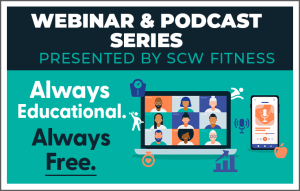 reaches in another direction. She sees more tech-driven workouts that seamlessly integrate technology with tracking progress, providing feedback, and enhancing the overall user experience. Gail also foresees more community-driven platforms, bringing together fitness programs that foster a sense of community, either through in-person classes or online forums. Social connections to help enhance motivation and commitment. Lastly, she envisions more programming dedicated to accessibility and flexibility. This not only refers to time, location, and workout intensity, but also accessibility for diverse populations, being implemented in studios, and personal trainers, both in-person and virtually.
reaches in another direction. She sees more tech-driven workouts that seamlessly integrate technology with tracking progress, providing feedback, and enhancing the overall user experience. Gail also foresees more community-driven platforms, bringing together fitness programs that foster a sense of community, either through in-person classes or online forums. Social connections to help enhance motivation and commitment. Lastly, she envisions more programming dedicated to accessibility and flexibility. This not only refers to time, location, and workout intensity, but also accessibility for diverse populations, being implemented in studios, and personal trainers, both in-person and virtually.
Sheldon notes the recent industry awareness of behavior modification, mental wellness, and holistic health will succeed in 2024. As predicted over the past three to five years, access to exercise through streaming options, wearables, studios, and social media has grown significantly. Fitness professionals can no longer rely on personality and extravagant programming to succeed. Success in 2024 will come from programs that stay on brand and can incorporate elements of rewarding behavior outside of exercise sessions, coaching applicable habits, fostering human-to-human connection, and providing resources to dial into passive or active recovery.
Question 3: How will these programs be set into studios, used with private trainers, and implemented virtually?
“The benefit of these approaches is that you can scale them to be facilitated virtually, taught in a small group, or 1:1. People like to be in person again these days, so although virtual is an important option, it won’t be your clients’ first choice.” States Irene.
Gail views each setting with a different outlook. Traditional fitness studios may incorporate technology and offer a mix of in-person and virtual classes. The focus could be on creating an immersive and engaging experience for participants. Personal trainers may leverage technology to provide virtual sessions, personalized workout plans, and real-time monitoring of clients’ progress. This allows for more flexibility and convenience. Fitness programs will continue to thrive on online platforms, offering a wide range of classes and personalized plans. Interactive features and social components can enhance the online fitness experience.
Sheldon’s take on program trends reaches another direction. Private Trainers, Studios, and Personal Training Managers have a host of resources at their fingertips to implement behavior modification, AI, wearables, and holistic health practices in their businesses. There are 3rd party providers of application-based services that businesses can white label and guide clients through step-by-step habits to improve health and fitness outcomes. Personal Trainers can use these resources to guide eating, sleeping, movement, meditation habits, and much more. There is a return on investment through improved retention by keeping clients longer. Essentially lifetime value will likely increase as clients hold hands with your service for the long-term gain.
Though at some cost, generative AI resources available today can provide powerful touchpoints to prospects and clients. They are capable of booking sessions, assigning programs, mapping drip and social media campaigns, and even selling memberships! It’s a brave step to take but one that will likely become a necessity in the coming years.
The other aspect to consider, in terms of implementation, is restoration and rejuvenation. Some Personal Trainers and Studios may already be well grounded in this. Perhaps they specialize in fascial release, stretch, corrective exercise, exercise with oxygen training, restorative yoga, etc. For most trainers and studios in 2024, it should now come to a minimal cost to operate with complementary percussion access, bookable leg compression, foam rolling and mobility classes, etc. using a 3rd party application or self-run rejuvenation meditation access online through streaming or on demand.
Question 4: How will we, as an industry, reach more people to engage in fitness and wellness?
Melissa thinks we have already seen the industry shifting, starting with the media. More articles, magazines, new shows, and commercials talk about things that used to be taboo. We are bringing the menopause concerns to the forefront with drugs to treat vasomotor symptoms (not my choice of treatment but it gets people talking). We see ads on TV for underwear specifically for stress incontinence (again, not treating the problem, just offering a band-aid, quite literally).
It seems the view of many consumers is still “quantity over quality”, according to Irene. She would like to see more people moving but in the right way. People still exercise wrong, using outdated thought processes for training, making form errors, and not understanding the biomechanical integration of the body. Irene’s thought is a new NATIONAL influencer, a qualified pro who can guide our nation into the 21st century of applied exercise science, not a social media persona turned “wanna-be” trainer.
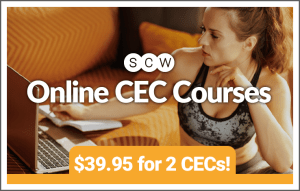 Gail points out that social media platforms and digital marketing strategies need more leveraging to showcase engaging content, success stories, and challenges to attract a broader audience.
Gail points out that social media platforms and digital marketing strategies need more leveraging to showcase engaging content, success stories, and challenges to attract a broader audience.
Question 5: How will we integrate with the medical profession now and in the future?
The only true experience Melissa has had with integration with the medical profession is in her fitness classes. Many of her water class participants have been directed by their physical therapists into her aqua classes after being released from therapy from joint replacement surgery. In her Pilates classes, several members were referred by their OBGYN for incontinence and hypotonic and hypertonic pelvic floor issues.
Irene’s perspective shifts in a completely different direction, the first focus needs to be on the fitness industry before tackling the medical professions. She feels we won’t get far with others until we start taking our professional community more seriously; licensure, registration, and national boards should be required for fitness pros. The only way to pursue those requirements is by increasing our value with a pay increase or another revenue stream.
The concept of integrating the medical world with the fitness industry is necessary yet challenging according to Sheldon. Fitness has long been categorized as a small business owner’s passion project. A great service with modest margins. That said, quite often there’s a golden rule that you don’t allow other companies (i.e. insurance) to dictate your prices or the return on your acquisition cost. Creating medical necessity can create leverage for FSA and HSA approval for gym discounts with the right coverage. This can sound like a lot of hoops to jump through. So, it’s key to know what we can do now as fitness professionals as this partnership potentially matures in the future.
The thing to note is that fitness does exist in the realm of the healthcare continuum by nature. The first step is to ensure you have a very credible and properly credentialed fitness practice that aligns with the medical professional leg of interest (post-rehab, weight loss, mental health, etc.). Running on-location workshops, contributing blogs/articles, and offering onsite fitness assessments are a few examples of practices you can establish. These types of practices establish healthy touchpoints with patients and decision-making staff. A simple and effective referral program is a clear best practice. Currently, my facility offers 4 weeks of complimentary post-rehab training, small group functional training, aquatics access, and free access to rejuvenation services (Red Light Therapy, Beemer, Compression, and more) through a Physician and Physical Therapy Referral program. We also offer complimentary access to managing staff who actively participate as a way to have their practices stand out in the community as an end-to-end service to patients.
There you have it, four diverse perspectives from the same fitness industry. Their opinions toward the future are quite different, but when you take a look at the whole, they relate to one another. Whether we as health and wellness professionals are working with men, women, seniors, kids, experienced, or new to exercise, 2024 will be a year of change, vision, growth, and progress. Take the time to think about these outlooks and maybe even write down your thoughts and visions. The key is to work together as a team, with support, confidence, and positivity. Strength in numbers and education will keep our worldwide family together.
For 40 years, SCW has been proud to be the top fitness education and certification company of choice for Group Exercise Instructors, Personal Trainers, Small Group Training Leaders, Aquatic Exercise Professionals, Cycling Instructors, Mind-Body Experts, Sport-Specific Training Educators, and many more. This outstanding Family of Leaders also supports Managers, Directors, and Owners of clubs and facilities nationwide with our Health & Fitness Business Summit and sessions.
MANIA® offers 7 Professional Training Conventions annually in Washington, D.C., California (San Francisco), Florida (Orlando), Atlanta, Dallas, Midwest (Chicago), and Boston. SCW serves over 7,000 health and wellness professionals at our events, and we reach more than 300,000 virtually through our SCW OnDemand program, Online Certifications, and Continuing Education Credit (CEC) programming options.
 About the Author: Melissa Layne, MEd
About the Author: Melissa Layne, MEd
Melissa Layne, MEd is a Kinesiology Department Faculty Member at the University of North Georgia. She has been a well-respected and well-loved fitness and nutrition leader for over 35 years. Having created the SCW Nutrition Coaching for Fitness Professionals Certification, the SCW Nutrition, Hormones & Metabolism Certification, and contributed to the SCW Active Aging Certification, Melissa has consistently sold-out educational seminars. She holds a Master of Education in Exercise Science, a bachelor’s degree in physical education, and an associate degree in Medical Terminology.
 About the Author: Irene McCormick, MS, CSCS
About the Author: Irene McCormick, MS, CSCS
Irene McCormick, MS, CSCS is an international fitness educator, adjunct faculty, twice-published author, IDEA Award Winner, and Subject Matter Expert. Creator of the Menopause Mentor, and the JUST START Coaching Program using wellness to master the symptoms of menopause. Irene is with Life Time Personal Training and Pilates Reformer in Des Moines Iowa.
 About the Author: Gail Bannister-Munn
About the Author: Gail Bannister-Munn
Gail Bannister-Munn is the Flexibility Specialist and Core, Yoga, & Pilates Coach with the New York Jets football team. Gail is the owner of The Bannister Method Studio out of Long Island, West Babylon, New York & is the Regional Group Ex Manager of Crunch Fitness Locations (Queens, Bronx, Brooklyn). Gail teaches several different class formats at national conferences and is a Fitness Consultant for professional athletes in the NBA, NFL, NHL, & MLB. She holds numerous certifications in several disciplines, including NASM, AFAA, FST L3, Thai Massage Specialist, Yoga Fit 500+ hrs., and is a NASM & AFAA Continuing Education Provider.
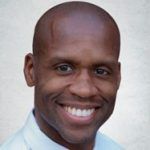 About the Author: Sheldon McBee
About the Author: Sheldon McBee
Sheldon McBee, MS holds a Master of Science degree in human nutrition. He is the Executive Director at Universal Athletic Club and is an ACE-certified Personal Trainer and Group Fitness Instructor with over 19 years of experience in health and fitness. Sheldon is an experienced international presenter, lecturer, educator, business consultant, and fitness content developer. He has presented at IHRSA, IDEA, Canfitpro, MACMA, SCW, and other industry conferences. He has been featured in numerous industry publications and sits on the Canfitpro and Club Solutions Magazine Advisory Panel.
Follow us on IG: https://www.instagram.com/scwmania/
Like our FB page: https://www.facebook.com/scwmania
Follow us on X: https://twitter.com/scw_mania
Connect with us on LinkedIn: https://www.linkedin.com/company/scwfit/
Follow us on IG:
https://www.instagram.com/scwmania/
Like our FB page:
https://www.facebook.com/scwmania
Follow us on X:
Connect with us on LinkedIn:

Four Heath Benefits of Hugs
by Francis McGlone and Susannah Walker
Courtesy of Bluezones.com
For many people, the thing they missed most during the pandemic was being able to hug loved ones. Indeed, it wasn’t until we lost our ability to hug friends and family did many realize just how important touch is for many aspects of our health – including our mental health.
And the good news is that not only do hugs feel good – they also have many health benefits.
The reason hugs feel so good has to do with our sense of touch. It’s an extremely important sense which allows us not only to physically explore the world around us, but also to communicate with others by creating and maintaining social bonds.
Touch consists of two distinct systems. The first is “fast-touch”, a system of nerves which allows us to rapidly detect contact (for example, if a fly landed on your nose, or you touched something hot). The second system is “slow-touch”. This is a population of recently discovered nerves, called c-tactile afferents, which process the emotional meaning of touch.
These c-tactile afferents have essentially evolved to be “cuddle nerves” and are typically activated by a very specific kind of stimulation: a gentle, skin-temperature touch, the kind typical of a hug or caress. We see c-tactile afferents as the neural input stage in signaling the rewarding, pleasurable aspects of social tactile interactions such as hugging and touching.
Touch is the first sense to start working in the womb (around 14 weeks). From the moment we’re born, the gentle caress of a mother has multiple health benefits, such as lowering heart rate and promoting the growth of brain cell connections.
When someone hugs us, the stimulation of c-tactile afferents in our skin sends signals, via the spinal cord, to the brain’s emotion processing networks. This induces a cascade of neurochemical signals, which have proven health benefits. Some of the neurochemicals include the hormone oxytocin, which plays an important role in social bonding, slows down heart rate, and reduces stress and anxiety levels. The release of endorphins in the brain’s reward pathways supports the immediate feelings of pleasure and well-being derived from a hug or caress.
Hugging has such a relaxing and calming effect that it also benefits our health in other ways.
It improves our sleep: From the benefits of co-sleeping with infants to cuddling your partner, gentle touch is known to regulate our sleep, as it lowers levels of the hormone cortisol. Cortisol is a key regulator of our sleep-wake cycle but also increases when we’re stressed. So it’s no wonder high levels of stress can delay sleep and cause fragmented sleep patterns or insomnia.
It reduces reactivity to stress: Beyond the immediate soothing and pleasurable feelings provided by a hug, social touch also has longer-term benefits to our health, making us less reactive to stress and building resilience.
Nurturing touch, during early developmental periods, produces higher levels of oxytocin receptors and lower levels of cortisol in brain regions that are vital for regulating emotions. Infants that receive high levels of nurturing contact grow up to be less reactive to stressors and show lower levels of anxiety.
Increases well-being and pleasure: Across our lifespan, social touch bonds us together and helps maintain our relationships. As noted, this is because it releases endorphins, which makes us see hugs and touch as rewarding. Touch provides the “glue” that holds us together, underpinning our physical and emotional well-being.
Touch provides the “glue” that holds us together, underpinning our physical and emotional wellbeing.
And when touch is desired, the benefits are shared by both people in the exchange. In fact, even stroking your pet can have benefits on health and wellbeing – with oxytocin levels increasing in both the pet and the owner.
It could help us fight off infections: Through regulation of our hormones – including oxytocin and cortisol – touching and hugging can also affect our body’s immune response. Whereas high levels of stress and anxiety can suppress our ability to fight infections, close, supportive relationships benefit health and well-being.
Research even suggests that cuddling in bed could protect us against the common cold. By monitoring hugging frequency among just over 400 adults who were then exposed to a common cold virus, researchers found the “huggers” won hands-down in being less likely to get a cold. And even if they did, they had less severe symptoms.
Hug it out
While it’s important we continue to keep ourselves safe, it’s equally as important that we don’t give up hugs forever. Social isolation and loneliness are known to increase our chances of premature death – and perhaps future research should investigate whether it’s a lack of hugs or social touch that may be driving this. Touch is an instinct that is all-around beneficial for our mental and physical health – so we should celebrate its return.
Touch is an instinct that is all-around beneficial for our mental and physical health
Of course, not everyone craves a hug. So for those that don’t, there’s no reason to worry about missing out on the benefits of hugs – as giving yourself a hug has also been shown to regulate emotional processes and reduce stress.
About the Authors
Francis McGlone is a Professor of Neuroscience at Liverpool John Moores University. Susannah Walker is a Senior Lecturer of Natural Sciences and Psychology at Liverpool John Moores University.
This article was first published on The Conversation.
Follow us on IG: https://www.instagram.com/scwmania/
Like our FB page: https://www.facebook.com/scwmania
Follow us on X: https://twitter.com/scw_mania
Connect with us on LinkedIn: https://www.linkedin.com/company/scwfit/
Follow us on IG:
https://www.instagram.com/scwmania/
Like our FB page:
https://www.facebook.com/scwmania
Follow us on X:
Connect with us on LinkedIn:

Understanding the Needs of Active Older Adults: What They Want from Fitness Pros
by Deborah Rothschild, MS
As the population ages, the number of active older adults participating in fitness activities has increased. These individuals seek to maintain and improve their overall health, mobility, and quality of life well into their later years. As a result, fitness professionals are increasingly catering to this demographic, but to effectively meet the needs of active older adults, it is essential to understand what they truly want, need, and expect. This article will explore the key factors active older adults seek from fitness professionals and how the fitness industry can better serve this growing and vital demographic. To further our understanding, we will hear directly from some of the older adult Tough Agers LLC clients and class participants.
One of the primary desires of active older adults is access to tailored exercise programs and classes specifically designed to meet their unique needs and abilities. They cannot be treated like those in their 30s, nor do they want to be treated like they are frail and delicate. Fitness professionals should understand that older adults often have different fitness goals, challenges, and health concerns compared to younger individuals. Therefore, they seek personalized training plans and classes that consider their physical limitations, existing medical conditions, and age-related factors. A customized approach focusing on strength, flexibility, balance, and cardiovascular health can help older adults maintain their independence and vitality. When asked, “Did you ever have a negative experience working with a personal trainer or taking a group fitness class?” Here are a few of their responses:
 “My one major problem was with a Pilates trainer who filled in for my regular trainer for a short time. She had previously worked with the Navy and was unable to adjust her expectations to a 70+ year-old. I reinjured my neck and still have problems with it.”
“My one major problem was with a Pilates trainer who filled in for my regular trainer for a short time. She had previously worked with the Navy and was unable to adjust her expectations to a 70+ year-old. I reinjured my neck and still have problems with it.”
“There were a few times when I was in the senior fitness class at the club that I belonged to, and they’d have a substitute that would come in. And a few of the substitutes didn’t put themselves in a way that they understood what the class was needing. In other words, they didn’t take into account the capabilities of the class we were in.”
“A group of us had been attending fitness classes together for many years under different leaders. The last leaders before Deborah were totally wrong for our Senior group. One told us what to do and then proceeded to demonstrate what she as a fitness professional could do, (which was of course, much better). Another tried to get us to do chair exercises, even though we were all capable of workouts standing and moving. Deborah saw the problem. She took over and designed exercises that fit our ages and abilities.”
Active older adults want to work with fitness professionals who have expertise in senior fitness and understand the physiological and psychological aspects of aging. They seek knowledgeable trainers familiar with the specific exercise techniques, safety considerations, and modifications most appropriate for older bodies. Moreover, these individuals want to feel understood and respected. It is paramount to have a fitness professional who can empathize with their unique needs and concerns. When asked, “What is it you want from fitness professionals today?” here are a couple of their responses:
“Someone who understands my age, limitations, and the required activities to keep me active, as well as to improve my posture and ability to do everyday activities.”
“I think the main thing is to have somebody who understands the condition that age puts you in. You know, I’m not as strong as I used to be. I can’t possibly do some of the exercises that I could do when I was in my thirties or forties. …I think that… whoever’s leading the class should be able to handle exercise in a way that I could fit in. And, for example, right now, in the fitness class ToughAgers® we always have an option to do things more simply or more difficult if we want to. …But it’s having a choice in there where you can fit in.”
Preventive health and injury prevention are top priorities for active older adults, and they expect fitness professionals to prioritize these aspects in their training programs. Older adults are often more prone to specific health issues and injuries, and they want to work with fitness professionals who can help them stay healthy, avoid common fitness-related injuries, and mitigate the risk of chronic conditions such as osteoporosis, arthritis, and heart disease. Fitness professionals who are proactive in addressing these concerns and promoting safe and effective exercise practices will earn the trust and loyalty of active older adults. Here are more responses to the question, “What do you want from fitness professionals today?”:
“For me, it’s also about how do I have longevity and stay healthy plus live an active lifestyle? So I think the people that I want to surround myself with in terms of fitness professionals are people that kind of understand that it’s not about having a certain percentage of body fat or anything like that. It’s more about, how do we have an active lifestyle that’s going to take us through our more senior years and have a fulfilling active life. So, I think just having people that understand that all of our bodies are different. And also, maybe we have an injury or we’re in pain, tailoring those workouts around that as well.”
“Someone dedicated to helping seniors stay fit.”
The concept of aging has undergone a profound transformation in recent years, and one of the most notable shifts is the changing perception of what it means to be a senior. Contrary to traditional stereotypes and societal expectations, many seniors today do not feel “old” in the conventional sense. Instead, they are embracing their vitality, pursuing active lifestyles, and redefining the narrative of aging. Therefore, fitness professionals need to understand that seniors are not defined by their age alone. When asked the question, “How old do you feel?” Here are some of their responses:
“It depends on the day, but I feel I am in far better condition than the average 83-year-old, at least those I have known in the past.”
“When I was a young man, I thought people that were 87 were, really really old. But I’ve changed the way I look at that. I mean the way I feel now is I have a lot more years than I would’ve thought when I was a young man.”
“I really feel like I’m in my forties (He’s 84). I move up and downstairs with ease… I can lift things that… I wasn’t able to lift…”
“I’m 82 now but feel younger than 82.”
“I’m 81. I feel younger but am slowing down. Out of energy sooner!”
Active older adults appreciate 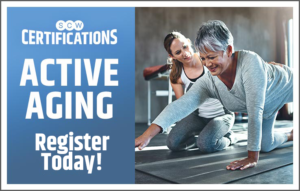 fitness professionals who foster a social environment within their training facilities. Many older adults enjoy the social aspect of group exercise classes or small training groups, as it allows them to connect with peers who share similar goals and interests. Fitness professionals who create a welcoming atmosphere can help older adults feel more engaged and motivated to participate in regular physical activity. When asked, “What do you like about ToughAgers® Classes, and how have you benefited from them?” here are some of their responses:
fitness professionals who foster a social environment within their training facilities. Many older adults enjoy the social aspect of group exercise classes or small training groups, as it allows them to connect with peers who share similar goals and interests. Fitness professionals who create a welcoming atmosphere can help older adults feel more engaged and motivated to participate in regular physical activity. When asked, “What do you like about ToughAgers® Classes, and how have you benefited from them?” here are some of their responses:
“Debbie is the best instructor! She constantly learns more ways to help us be healthy. I have made many good friends in her classes, and we enjoy each other so much.”
“When Covid hit and left us all separated from our peers and families, she (Deborah) designed ZOOM workouts designed for the abilities of our age group. They had alternative movements for those with different abilities. They also included a few minutes before and after to socialize and reconnect with each other. It was very important for all of us both physically and mentally. She has continued these classes to the benefit of our group.”
The needs and expectations of active older adults are diverse and require a nuanced approach from fitness professionals. By understanding and addressing these needs, fitness professionals can better serve this growing demographic and contribute to the health and well-being of older adults in our communities. By providing tailored exercise programs and classes, expertise in senior fitness, emphasizing preventive health and injury prevention, professional understanding, and creating a social environment, fitness professionals can support active older adults’ ability to thrive.
When asked, “How have you benefitted from ToughAgers® classes?” here is one participant’s response, “I started Deborah’s classes in my early 70’s. At age 87, I am still in excellent health. I take only a single pill (a mild diuretic). I still play competitive tennis twice a week with other somewhat younger guys. These guys have all had physical and medical problems that I have so far managed to avoid.
Of course, I have lost muscle mass despite my exercise program, but I have not pulled a muscle in the last 12 years. In earlier times, a pulled muscle was not an unusual occurrence. I also have the energy to be the leader of a 9-piece senior entertainment band. I can only believe that the ToughAgers® class has played a large part in my current health and well-being.”
Learn how to teach and train active older adults with the ToughAgers® Active Older Adult Fitness Course. For more information, go to www.toughagers.com. I’d love to meet you in person. Join me at SCW DC MANIA®, February 23-25 at the Hyatt Regency Dulles. I’ll be sampling a few of my ToughAgers® classes throughout the 3-day convention. Get registered today and save $100.
 About the Author: Deborah Rothschild, MS
About the Author: Deborah Rothschild, MS
Deborah Rothschild, MS, began her fitness career in 2003 as a Certified Personal Trainer. She has worked as a Group Fitness Instructor, Pilates Instructor, Lead Trainer, Group Fitness & Pilates Manager, Fitness Director, and Sports & Wellness Director. Her specializations include ACE-Senior Fitness Specialist & Brain Health Trainer, NFPT-Cancer Recovery Specialist, BHOF-BoneFit Instructor, and Parkinson Wellness Recovery-PWR!Moves Instructor. She owns Tough Agers, LLC, a virtual and on-location fitness company that specializes in working with older adults of all fitness levels and capabilities.
Follow us on IG: https://www.instagram.com/scwmania/
Like our FB page: https://www.facebook.com/scwmania
Follow us on X: https://twitter.com/scw_mania
Connect with us on LinkedIn: https://www.linkedin.com/company/scwfit/
Follow us on IG:
https://www.instagram.com/scwmania/
Like our FB page:
https://www.facebook.com/scwmania
Follow us on X:
Connect with us on LinkedIn:

Goodbye Back Pain
by Julie Zuleger
Is back pain sidelining you from the activities you enjoy? Or do you bend down to pick something up and feel pain lifting or can’t stand up straight? Does any of this sound familiar? Say goodbye to the pain and discomfort and live your life fully.
Well-documented clinical research has concluded 70-85% of all pain is believed to come from little, tiny knots in the muscle (clinically known as trigger points). The good news is pain caused by muscle knots can be easy to fix. Pain in the back can come from many different muscles throughout the body. Back pain can be caused by muscles in the hamstrings, glutes, lower back, and upper back. Many people suffer from low back pain due to incorrect lifting, posture, and flexibility.
There are many myths about back pain. Some of these include:
- Myth: Back pain is always caused by a serious medical condition. Fact: While back pain can result from serious medical conditions, most cases of back pain are caused by muscle strains or spasms, muscle knots, poor posture, or injuries resulting from activities such as bending or lifting.
- Myth: Bed rest is the best treatment for back pain. Fact: Bed rest is not recommended for treating back pain, as it can lead to muscle weakness and stiffness. Instead, moderate exercise, incorporating active recovery techniques, and stretching can help promote healing and reduce pain.
- Myth: Painkillers are the best treatment for back pain. Fact: While over the counter or prescription pain medications can help manage back pain symptoms, they should not be relied upon as the sole treatment for back pain.
- Myth: Surgery is the only solution for back pain. Fact: Surgery is typically only recommended for people with severe or chronic back pain that cannot be managed through other treatments.
- Myth: Back pain only affects older adults. Fact: Back pain can affect people of all ages, from children to older adults. Younger people may be more prone to back pain due to poor posture, lack of physical activity, or spending long periods sitting or looking at screens.
- Myth: Exercise can make back pain worse. Fact: Certain exercises, such as yoga, Pilates, muscle compression with tools (Self-myofascial release with tools) and stretching can be especially beneficial for back pain sufferers.
- Myth: Heat is always the best method for reducing back pain. Fact: While heat therapy can be helpful for some types of back pain, such as muscle strains, it is not always the best method for reducing pain. Cold therapy may be more effective for other types of back pain, such as inflammation.
- Myth: There is no way to prevent back pain. Fact: While it may not be possible to completely prevent all types of back pain, there are steps you can take to reduce your risk of developing back pain. These include maintaining good posture, practicing safe lifting techniques, getting regular exercise, flexibility, strength training/lifting weights/resistance band training, and maintaining a healthy weight.
Knowing what to do can be 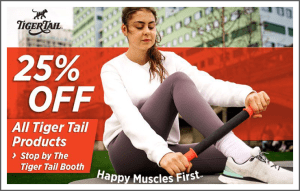 confusing. It is becoming evident that resting and doing nothing can worsen back pain. Incorporating activities such as foam rolling, movement, stretching, and flexibility can help improve symptoms and reduce pain. Goodbye Back Pain is a workshop based on The Tiger Tail Method which breaks down into 3 parts:
confusing. It is becoming evident that resting and doing nothing can worsen back pain. Incorporating activities such as foam rolling, movement, stretching, and flexibility can help improve symptoms and reduce pain. Goodbye Back Pain is a workshop based on The Tiger Tail Method which breaks down into 3 parts:
- Roll and Warm Up
The warmup phase consists of breathing techniques to activate the parasympathetic nervous system to relax the body along with dynamic movements to warm the muscles and fascial tissues.
The purpose of muscle rolling is to warm up the fascial tissues and to release tension. Releasing muscle tension assists in decreasing overactive tissues in the body and introduces mobility in the myofascial tissues of the body.
- Release
In the release or stretch phase, we will incorporate various forms of dynamic, active, and static stretching to improve mobility, and neuromuscular efficiency, and return tissues to their normal resting length.
Rolling and Release will be combined by muscle group.
- Restore
In this phase, we will focus on strengthening the muscles that were stretched. We incorporate dynamic movement patterns to improve the function of the body.
One example is rolling the lower back with the Tiger Tail 18” roller, stretching the lower back followed by active movement. Below is a sample sequence that is taught in our Goodbye Back Pain class at SCW MANIA® Conventions.
Roll:
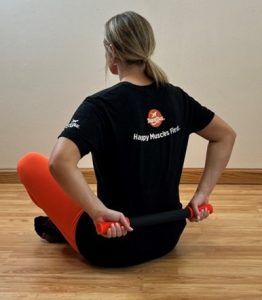
Low Back – 18″ roller
Release
Knee to chest stretch
- Lay on your back with legs extended on the floor.
- Pull right knee to chest grasping your knee with both hands. Keep your head on the floor with the gaze looking at the ceiling. It is important to keep the neck in a neutral position.
- Gently pull the knee closer to the chest.
- Hold for 20 – 30 seconds. Repeat 3-5 times
- if you feel pain in your low back, bend the other knee
- Repeat pulling left knee to chest.
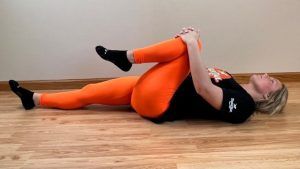
Seated Spinal Twist
- Sit on the floor with your legs extended straight in front of you.
- Bend your right knee and place it over your left leg, so your right foot is flat on the floor next to your left thigh.
- Keep your left leg extended and your foot flexed.
- Sit up tall, lengthening your spine, and maintain a neutral position by avoiding rounding or arching your back.
- On an exhale, twist your torso to the right, placing your left hand on the outside of your right knee or thigh.
- Place your right hand behind your back, either on the chair or the floor, for support.
- Inhale deeply and elongate your spine even more, feeling the twist starting from the base of your spine and gradually moving up to your neck.
- With each exhale, gently deepen the twist, being mindful not to strain your muscles.
- Hold the twist for 30 seconds to 1 minute, breathing deeply and allowing your body to relax and settle into the pose.
- When you are ready to release the twist, inhale deeply, and on an exhale, slowly unwind your torso back to the center.
- Extend both legs forward and take a moment to notice any changes or sensations in your spine.
- Repeat the entire sequence on the opposite side by bending your left knee and twisting your torso to the left.
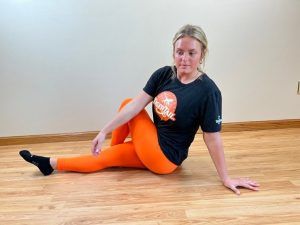
Restore
Cat Cow stretch
- Start in a kneeling position with hips over knees and shoulders over wrists.
- Back is in a neutral position.
- Inhale as you arch the back. Bring the head up and tilt the pelvis up. See Photo A.
- Exhale as you round the back. Drop the head and pelvis. See Photo B.
- Keep the core engaged during the movement.
- Repeat 8-10 times.
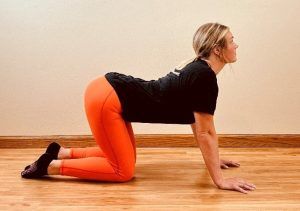
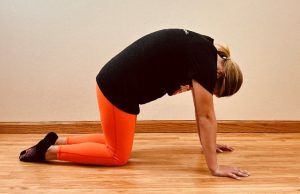
For more information on Tiger Tail courses and tools, visit www.tigertailusa.com/classes or email wellness@tigertailusa.com. We will be presenting Goodbye Back Pain at SCW DC and California MANIA®. In this course, we will look at contributing factors and assessments that personal trainers can incorporate with their clients along with how to use Tiger Tail tools and Tiger Tail Methods to help clients reduce pain and become more active.
Join us at DC MANIA®, February 23- 25, 2024 at the Hyatt Regency Dulles Hotel, California MANIA®, March 22-24, and Florida MANIA®, May 3-5. Tiger Tail USA will be presenting sessions on Tiger Tail® Goodbye Back Pain and many more. Stop by the Tiger Tail booth at the FREE Expo for great deals on Tiger Tail muscle care tools.
 About the Author: Dr. Julie Zuleger
About the Author: Dr. Julie Zuleger
Dr. Julie Zuleger has over 20 years of experience as a Licensed Massage Therapist, Certified Strength, and Conditioning Specialist (CSCS), Corrective Exercise Specialist, RYT-500 Yoga Instructor, and Human Movement Specialist. Julie promotes self-care using massage tools and stretching-based programs and teaches continuing education courses for yoga teachers, massage therapists, athletic trainers, strength and conditioning, fitness, and wellness professionals. Julie holds a PhD in Education and is the Director of Kinesiology and Education at Tiger Tail USA.
Follow us on IG: https://www.instagram.com/scwmania/
Like our FB page: https://www.facebook.com/scwmania
Follow us on X: https://twitter.com/scw_mania
Connect with us on LinkedIn: https://www.linkedin.com/company/scwfit/
Follow us on IG:
https://www.instagram.com/scwmania/
Like our FB page:
https://www.facebook.com/scwmania
Follow us on X:
Connect with us on LinkedIn:

Understanding the Mind-Body Connection: Healing Our Way to Health
by Jani Roberts
 About the Author: Jani Roberts
About the Author: Jani Roberts
Jani Roberts is a Shamanic Practitioner and the Owner of Alignment Essentials, a health and wellness company spanning the movement, self-improvement, and mindfulness spaces. She is the creator of the Living in Alignment Program, Warrior® Practices, and Moving Meditations™. She is an international bestselling author and has over 45 years of experience in the health and wellness fields. She holds numerous certifications and presents globally helping thousands of people find more Joy. In the summer months, you can find her hosting retreats in the mountains of Pennsylvania.
Follow us on IG: https://www.instagram.com/scwmania/
Like our FB page: https://www.facebook.com/scwmania
Follow us on X: https://twitter.com/scw_mania
Connect with us on LinkedIn: https://www.linkedin.com/company/scwfit/
Follow us on IG:
https://www.instagram.com/scwmania/
Like our FB page:
https://www.facebook.com/scwmania
Follow us on X:
Connect with us on LinkedIn:

Four Hleath Benefits of Hugs
by Francis McGlone and Susannah Walker
Courtesy of Bluezones.com
For many people, the thing they missed most during the pandemic was being able to hug loved ones. Indeed, it wasn’t until we lost our ability to hug friends and family did many realize just how important touch is for many aspects of our health – including our mental health.
And the good news is that not only do hugs feel good – they also have many health benefits.
The reason hugs feel so good has to do with our sense of touch. It’s an extremely important sense which allows us not only to physically explore the world around us, but also to communicate with others by creating and maintaining social bonds.
Touch consists of two distinct systems. The first is “fast-touch”, a system of nerves which allows us to rapidly detect contact (for example, if a fly landed on your nose, or you touched something hot). The second system is “slow-touch”. This is a population of recently discovered nerves, called c-tactile afferents, which process the emotional meaning of touch.
These c-tactile afferents have essentially evolved to be “cuddle nerves” and are typically activated by a very specific kind of stimulation: a gentle, skin-temperature touch, the kind typical of a hug or caress. We see c-tactile afferents as the neural input stage in signaling the rewarding, pleasurable aspects of social tactile interactions such as hugging and touching.
Touch is the first sense to start working in the womb (around 14 weeks). From the moment we’re born, the gentle caress of a mother has multiple health benefits, such as lowering heart rate and promoting the growth of brain cell connections.
When someone hugs us, the stimulation of c-tactile afferents in our skin sends signals, via the spinal cord, to the brain’s emotion processing networks. This induces a cascade of neurochemical signals, which have proven health benefits. Some of the neurochemicals include the hormone oxytocin, which plays an important role in social bonding, slows down heart rate, and reduces stress and anxiety levels. The release of endorphins in the brain’s reward pathways supports the immediate feelings of pleasure and well-being derived from a hug or caress.
Hugging has such a relaxing and calming effect that it also benefits our health in other ways.
It improves our sleep: From the benefits of co-sleeping with infants to cuddling your partner, gentle touch is known to regulate our sleep, as it lowers levels of the hormone cortisol. Cortisol is a key regulator of our sleep-wake cycle but also increases when we’re stressed. So it’s no wonder high levels of stress can delay sleep and cause fragmented sleep patterns or insomnia.
It reduces reactivity to stress: Beyond the immediate soothing and pleasurable feelings provided by a hug, social touch also has longer-term benefits to our health, making us less reactive to stress and building resilience.
Nurturing touch, during early developmental periods, produces higher levels of oxytocin receptors and lower levels of cortisol in brain regions that are vital for regulating emotions. Infants that receive high levels of nurturing contact grow up to be less reactive to stressors and show lower levels of anxiety.
Increases well-being and pleasure: Across our lifespan, social touch bonds us together and helps maintain our relationships. As noted, this is because it releases endorphins, which makes us see hugs and touch as rewarding. Touch provides the “glue” that holds us together, underpinning our physical and emotional well-being.
Touch provides the “glue” that holds us together, underpinning our physical and emotional wellbeing.
And when touch is desired, the benefits are shared by both people in the exchange. In fact, even stroking your pet can have benefits on health and wellbeing – with oxytocin levels increasing in both the pet and the owner.
It could help us fight off infections: Through regulation of our hormones – including oxytocin and cortisol – touching and hugging can also affect our body’s immune response. Whereas high levels of stress and anxiety can suppress our ability to fight infections, close, supportive relationships benefit health and well-being.
Research even suggests that cuddling in bed could protect us against the common cold. By monitoring hugging frequency among just over 400 adults who were then exposed to a common cold virus, researchers found the “huggers” won hands-down in being less likely to get a cold. And even if they did, they had less severe symptoms.
Hug it out
While it’s important we continue to keep ourselves safe, it’s equally as important that we don’t give up hugs forever. Social isolation and loneliness are known to increase our chances of premature death – and perhaps future research should investigate whether it’s a lack of hugs or social touch that may be driving this. Touch is an instinct that is all-around beneficial for our mental and physical health – so we should celebrate its return.
Touch is an instinct that is all-around beneficial for our mental and physical health
Of course, not everyone craves a hug. So for those that don’t, there’s no reason to worry about missing out on the benefits of hugs – as giving yourself a hug has also been shown to regulate emotional processes and reduce stress.
About the Authors
Francis McGlone is a Professor of Neuroscience at Liverpool John Moores University. Susannah Walker is a Senior Lecturer of Natural Sciences and Psychology at Liverpool John Moores University.
This article was first published on The Conversation.
Follow us on IG: https://www.instagram.com/scwmania/
Like our FB page: https://www.facebook.com/scwmania
Follow us on X: https://twitter.com/scw_mania
Connect with us on LinkedIn: https://www.linkedin.com/company/scwfit/
Follow us on IG:
https://www.instagram.com/scwmania/
Like our FB page:
https://www.facebook.com/scwmania
Follow us on X:
Connect with us on LinkedIn:

Do I Have to Count Calories to Lose Weight?
by Amber Toole
In January, many people begin adopting healthy behaviors and one of the most popular New Year’s Resolutions is eating better. Likely, this comes as a result of a desire to lose weight. Part of a weight loss program is going to be a healthy diet.
But do you really have to count calories in order to lose weight?
The short answer is no, but the long answer involves a nuanced understanding of the relationship between calories, food quality, and successful weight loss.
Calories certainly play a crucial role in the weight loss equation – it’s a matter of energy balance. In the beginning, it’s very helpful to understand how many calories you are consuming and how your body is responding to that amount of energy. For some people, that is going to be a process of weighing your food portions and tracking in a food journal how many calories you are eating. This does not have to be long-term. Doing this for 3 – 7 days will give you enough data to see where your average daily intake lies.
And although a deficit of calories will lead to weight loss, that is not the only focus. The quality of the calories you consume is equally important. Fueling your body with more nutrient-dense foods will help to increase your health, give you an abundance of energy, and help to preserve your muscle mass while in a deficit.
 If you only look at your caloric intake, you may end up missing out on nutrients that your body needs. As an example, eating 100 calories of chocolate and 100 calories of a bowl of vegetables is the same caloric value. However, the impact on your overall health and your weight loss journey is vastly different between these two foods. Not to say that both can’t fit in a healthy diet, they absolutely can! But they are not equal in nutrients.
If you only look at your caloric intake, you may end up missing out on nutrients that your body needs. As an example, eating 100 calories of chocolate and 100 calories of a bowl of vegetables is the same caloric value. However, the impact on your overall health and your weight loss journey is vastly different between these two foods. Not to say that both can’t fit in a healthy diet, they absolutely can! But they are not equal in nutrients.
An easy way to map out your plate, both to ensure proper portion sizes and inclusion of all the macronutrients, is to use your HAND as a guide.
Fist-Sized Portions – Vegetables
You can season them with herbs and spices, roast them with a little olive oil, or make a colorful and interesting salad with many different veggies.
Palm-Size (both the size and thickness of your palm) – Protein
Chicken, turkey, and fish are great choices to ensure you get all the amino acids you need to support your muscles.
Cup your hand – Starchy Carbohydrate
Foods like a root vegetable (potatoes) or a grain (rice, pasta, bread.)
Thumb-Size – Heart-Healthy Fat
Avocados, nuts, or seeds are perfect for adding to a salad or on a sandwich.
As you have a clearer picture of the number of calories you are eating, you can make better decisions about what goes on your plate. It’s a good practice to revisit the weighing of your food occasionally to ensure you haven’t accidentally increased your portion sizes. But you don’t have to do this every day to be successful.
Once you have become aware of the number of calories you are eating, try these three tips to make healthy eating for weight loss a more achievable and sustainable endeavor:
Prioritize Whole Foods:
Instead of fixating on calorie counts, center your meals around whole, minimally processed foods. Vegetables, fruits, lean proteins, and whole grains not only provide essential nutrients but also offer a sense of satiety that processed foods often lack. These nutrient-dense choices fuel your body efficiently and contribute to long-term weight management.
Listen to Your Body:
Pay attention to your body’s hunger and fullness cues. Eating mindfully and savoring each bite allows you to recognize when you’re satisfied, preventing  overeating. Cultivating a healthy relationship with food involves tuning in to your body’s signals rather than adhering strictly to external guidelines. This approach fosters a sustainable and enjoyable eating pattern.
overeating. Cultivating a healthy relationship with food involves tuning in to your body’s signals rather than adhering strictly to external guidelines. This approach fosters a sustainable and enjoyable eating pattern.
Moderation, Not Deprivation:
Weight loss is not about deprivation; it’s about finding a balance that works for you. Allow yourself occasional treats and indulgences in moderation. The key is not to view certain foods as off-limits or “bad” but to incorporate them sensibly into your overall diet. This helps prevent feelings of restriction and promotes a healthier mindset around food.
In conclusion, while calories undeniably matter in the weight loss journey, an exclusive focus on counting them may not be the most effective or sustainable approach. Prioritizing food quality, listening to your body, and embracing moderation can make the path to a healthier weight more enjoyable and realistic. Remember, it’s not just about losing weight; it’s about fostering a sustainable and nourishing lifestyle.
 About the Author: Amber Toole
About the Author: Amber Toole
Amber Toole is an ACE Certified Personal Trainer with a Bachelor of Science degree in Physical Education and Health from Georgia Southern University. She has 30 years of experience in the Fitness Industry and loves to share her expertise with other Fitness Professionals. It is her life’s mission to spread the truth about fitness and nutrition through education. She is the owner of The Training Toole – a Fitness and Nutrition Studio in Ocala, Florida, and an SCW Educator and Fit Pro Mentor.
Follow us on IG: https://www.instagram.com/scwmania/
Like our FB page: https://www.facebook.com/scwmania
Follow us on X: https://twitter.com/scw_mania
Connect with us on LinkedIn: https://www.linkedin.com/company/scwfit/
Follow us on IG:
https://www.instagram.com/scwmania/
Like our FB page:
https://www.facebook.com/scwmania
Follow us on X:
Connect with us on LinkedIn:
Looking for a New Job? SCW Can Help!
Facilities need you! Whether it’s Teachers, Trainers, Directors, or Managers, SCW’s new FREE JOB BOARD is supporting the industry’s need for qualified fitness pros.
We post openings in all three of our monthly e-newsletters: Spotlite, Health & Fitness Business News, and Tidal Waves which are emailed out to tens of thousands of fitness professionals teaching and training in all formats along with managers and directors at all fitness facilities: big box, gyms, boutique, studios, not for profits and independent centers.
Social Media Assistant
SCW Fitness Education – Remote
This part time virtual Social Media Assistant is responsible for managing the SCW social media for MANIA, WATERinMOTION, SEAT Fitness and Sara Kooperman. This is a 10-20 hour part-time position that is responsible for instagram, facebook, linkedin and tik tok.
Aqua Fitness Instructor
Midtown Athletic Club – Bannockburn, IL
Midtown is searching for Aqua Fitness Instructors to teach and motivate our members to achieve their goals through classes in the Pool at Midtown!
Must have AM availability.
Aqua Instructor
Central YMCA – Arlington, TX
We are looking for passionate certified aqua instructors for our summer outdoor pool classes. The class schedule begins the end of May and runs through early September and the class times are 7:15a and 8:15a.
Exercise Physiologist
Woman’s Center for Wellness – Baton Rouge, LA
Conducts 1-on-1 and group training exercise sessions with cancer survivors, bone health sufferers, and other related diagnoses. Other duties include exercise testing and evaluation, and the development of appropriate exercise programs. Performs other duties assigned by department management. Must be knowledgeable of exercise standards and guidelines established by the ACSM.
Wellness Specialist
Orange County Sheriff’s Office – Orlando, FL
Functions as a trained subject matter expert in the area of fitness and wellness by developing programming and providing instruction, education, coaching and encouraging individuals to adopt personal healthy lifestyle habits and behaviors by performing the following duties.
Group Exercise Instructor
Woman’s Center for Wellness – Baton Rouge, LA
Candidate will instruct fitness classes, such as Yoga, Indoor Cycling, Aqua, Mat Pilates, Zumba, strength training, etc.
Candidate must have group exercise certification, professional liability insurance and CPR/AED required; specialty certification in Yoga, Indoor Cycling, Aqua, REFIT, HIIT, Mat Pilates, Zumba, strength training and/or circuit preferred.
Group Fitness Instructor
F45 Training Longmont – Longmont, CO
We’re looking for personable & high-energy coaches to deliver a top-notch studio experience for our group training HIIT workouts. The people we’re looking for:
- Have a growth mindset and want to be part of a professional team.
- Thrive in a fast-paced environment.
- Come alive in front of a group!
Assistant Director, Fitness
Leonard J. Kaplan Center for Wellness – UNC Greensboro
The Assistant Director, Fitness is responsible for the overall design, management, and implementation of a comprehensive fitness program for the students, faculty, staff and UNC Greensboro community. This includes leadership of two professional positions and a graduate assistant as well as student employees.
 We’re always looking for great content highlighting the newest things in the world of fitness. Please submit your article directly to editor@scwfit.com for immediate consideration!
We’re always looking for great content highlighting the newest things in the world of fitness. Please submit your article directly to editor@scwfit.com for immediate consideration! Spotlite, April 9, 2025
Spotlite, January 5, 2025
Spotlite, November 11, 2024
Spotlite, September 27, 2024
Spotlite, August 31, 2024
Spotlite, July 26, 2024
Spotlite, June 22, 2024
Spotlite, May 23, 2024
Spotlite, April 26, 2024
Spotlite, March 22, 2024
Spotlite, February 19, 2024
Spotlite, January 20, 2024
Spotlite, December 21, 2023
Spotlite, November 18, 2023
Spotlite, October 22, 2023
Spotlite, September 21, 2023
Spotlite, August 19, 2023
Spotlite, July 19, 2023
Spotlite, June 19, 2023
Spotlite, May 18, 2023
Spotlite, April 21, 2023
Spotlite, March 28, 2023
Spotlite, February 18, 2023
Spotlite, January 21, 2023
Spotlite, December 16, 2022
Spotlite, November 19, 2022
Spotlite, October 22, 2022
Spotlite, September 24, 2022
Spotlite, August 23, 2022
Spotlite, July 22, 2022
Spotlite, June 20, 2022
Spotlite, May 18, 2022
Spotlite, April 20, 2022
Spotlite, March 25, 2022
Spotlite, February 17, 2022
Spotlite, January 14, 2022
Spotlite, December 17, 2021
Spotlite, November 18, 2021
Spotlite, October 25, 2021
Spotlite, September 16, 2021
Spotlite, August 9, 2021
Spotlite, July 10, 2021
Spotlite, June 8, 2021
Spotlite, May 14, 2021
Spotlite, April 30, 2021
Spotlite, March 30, 2021
Spotlite, February 23, 2021
Spotlite, January 20, 2021
Hyatt Regency Dulles
Herndon, VA
Hyatt Regency SF Airport
Burlingame, CA
Caribe Royale Orlando
Orlando, FL
May 1-4, 2025
May 2026
Grand Hyatt Atlanta Buckhead
Atlanta, GA
July 24-27, 2025
July 2026
Westin Galleria Dallas
Dallas, TX
August 21-24, 2025
August 28-30 2026
Rosemont Chicago O’Hare
Rosemont, IL
Oct. 2-5, 2025
Oct. 2-4 2026
Doubletree by Hilton
Danvers, MA
Nov. 13-16, 2025
Nov. 13-15, 2026

